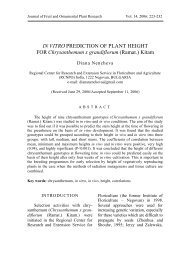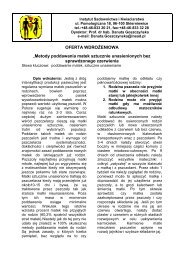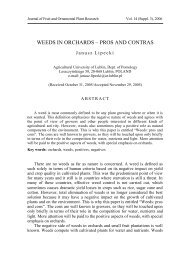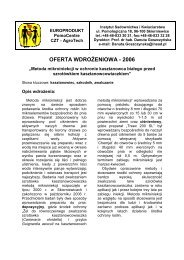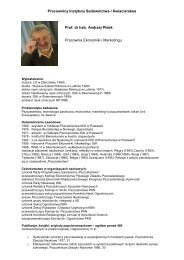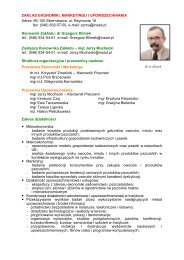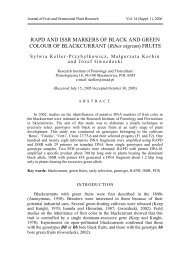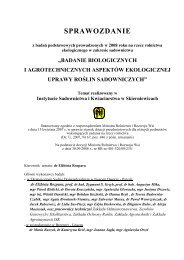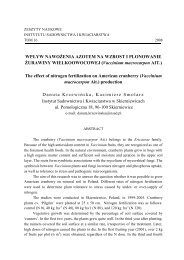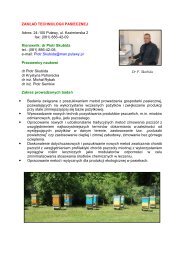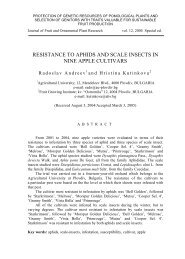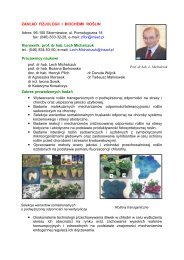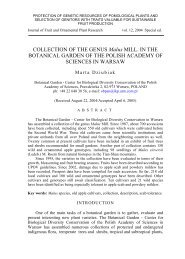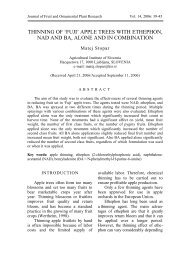mangosteen thrips: collection, identification and control
mangosteen thrips: collection, identification and control
mangosteen thrips: collection, identification and control
Create successful ePaper yourself
Turn your PDF publications into a flip-book with our unique Google optimized e-Paper software.
Journal of Fruit <strong>and</strong> Ornamental Plant Research Vol. 17/(2) 2009: 219-233<br />
MANGOSTEEN THRIPS: COLLECTION,<br />
IDENTIFICATION AND CONTROL<br />
A f f a ndi an d D eni Em ilda<br />
Indonesian Tropical Fruits Research Institute, PO Box 5 Solok 27301<br />
West Sumatra, INDONESIA<br />
e-mail: Aff<strong>and</strong>i1970@yahoo.com<br />
(Received November 17, 2008/Accepted May 4, 2009)<br />
A B S T R A C T<br />
The <strong>mangosteen</strong> international st<strong>and</strong>ard for export requires fruit free from scar.<br />
This was the most constraining issue for the Indonesian export of <strong>mangosteen</strong>. Thrips<br />
are pests which cause scars on <strong>mangosteen</strong> fruits. Hence, there is an inevitable need to<br />
<strong>control</strong> the <strong>thrips</strong> population. This research was aimed at identifying the <strong>thrips</strong> pest<br />
that causes scars on the <strong>mangosteen</strong> fruit. This project was also aimed at studying the<br />
effects of using yellow fluorescent sticky trap (YST), <strong>and</strong> the combination treatment:<br />
YST <strong>and</strong> intensive orchard care (YST+IOC) on the percentage <strong>and</strong> intensity of fruit<br />
scars caused by <strong>thrips</strong>. The research was conducted at a farm with a polycultured<br />
<strong>mangosteen</strong> orchard in Lima Puluh Kota, West Sumatra, Indonesia. It was conducted<br />
during the two fruit seasons from September 2006 to February 2007, <strong>and</strong> from<br />
October 2007 to February 2008. The results showed that there were two species of<br />
<strong>thrips</strong> pests that are associated with the <strong>mangosteen</strong>: Scirto<strong>thrips</strong> dorsalis (Hood) <strong>and</strong><br />
Seleno<strong>thrips</strong> rubrocintus Giard. All of the treatments gave significant differences in<br />
decreasing the percentage <strong>and</strong> intensity of scars. These differences were significantly<br />
different compared to the <strong>control</strong> group in the first year as well as in second year. The<br />
combined treatment of YST+IOC proved to have the best results in reducing the<br />
percentage (41.19% <strong>and</strong> 43.96%) <strong>and</strong> intensity of scars (32.14% <strong>and</strong> 15.81%) in the<br />
first year as well as in the second year, respectively.<br />
Key words: <strong>mangosteen</strong>, <strong>thrips</strong>, <strong>identification</strong>, <strong>control</strong><br />
INTRODUCTION<br />
Mangosteen in Indonesia has a very<br />
good possibility for being used for both<br />
domestic market <strong>and</strong> overseas export.<br />
The plants are widely grown throughout<br />
the country; hence, it is expected to<br />
become a major Indonesian fruit<br />
export. Indonesia is one of the main<br />
<strong>mangosteen</strong> producing countries in
Aff<strong>and</strong>i <strong>and</strong> D. Emilda<br />
the world as well as Thail<strong>and</strong> <strong>and</strong><br />
Malaysia (Poerwanto, 2000). Mangosteen<br />
juice is rich in the super antioxidants<br />
called xanthones. Xanthones<br />
have been known to kill or stop the<br />
spread of viruses, fungi, bacteria, <strong>and</strong><br />
free radicals which are strongly<br />
associated with cancer. Medical science<br />
reveals that xanthones inhibit the<br />
oxidation of low density lipoprotein<br />
(LDL) one of the causes of arteriosclerosis<br />
(hardening of the arteries)<br />
<strong>and</strong> heart attacks (Dench, 2008).<br />
Furthermore, <strong>mangosteen</strong> juice has<br />
been proven to promote healing of<br />
such medical conditions as diabetes,<br />
premature aging <strong>and</strong> arthritis (Dench,<br />
2008).<br />
Indonesian <strong>mangosteen</strong> fruit<br />
export in 2000 reached 7 182 tons<br />
worth US $ 5 885 035 <strong>and</strong> contributed<br />
to 45% of the total fruit<br />
exports value (Winarno, 2002). After<br />
2000, Indonesian <strong>mangosteen</strong> export<br />
value declined. One of the problems<br />
in exporting <strong>mangosteen</strong> fruit is the<br />
high percentage of visible fruit scar.<br />
From 2001 till 2006, only 4.9-13.1%<br />
of total Indonesian <strong>mangosteen</strong><br />
production fulfiled international<br />
st<strong>and</strong>ard export quality (Indonesian<br />
Department of Agriculture, 2007).<br />
Preliminary studies show that it is the<br />
<strong>thrips</strong> (Thysanoptera : Thripidae)<br />
infestation that caused the scars on<br />
the <strong>mangosteen</strong> fruit. The pest is also<br />
known to cause scars on other fruit<br />
such as apples (Childs, 1927; Jacob,<br />
1995), grapes (McNally et al., 1985),<br />
<strong>and</strong> avocados (Dennill <strong>and</strong> Erasmus,<br />
1992b; Hoddle <strong>and</strong> Morse, 1997).<br />
Typical symptoms include: silvering<br />
of fruit skin, pale yellow/brown<br />
220<br />
discoloration, elongated <strong>and</strong> patchy<br />
scars or hardened scars, <strong>and</strong><br />
“alligator skin”-like scars that may<br />
cover the entire fruit surface. Heavily<br />
scarred skin can sometimes prevent<br />
normal fruit growth.<br />
Methods of <strong>control</strong>ling <strong>thrips</strong> on<br />
<strong>mangosteen</strong> fruit are not yet available.<br />
However, several <strong>control</strong> methods of<br />
<strong>thrips</strong> on others fruit can be adopted<br />
such as applying botanical pesticides as<br />
“Sabadilla” derived from the seeds of<br />
Schoenocaulon officinale, as well as<br />
biopesticides such as abamectin <strong>and</strong><br />
spinosad (Hoddle et al., 1998; Wee et<br />
al., 1999; Faber et al., 2000; Astridge<br />
<strong>and</strong> Fay, 2006). Other cultural <strong>control</strong><br />
techniques which could be used to<br />
reduce <strong>thrips</strong> population are: composted<br />
organic yard waste, composted mulch<br />
applied under plant canopy, <strong>and</strong><br />
augmentation of predatory <strong>thrips</strong><br />
Franklino<strong>thrips</strong> orizabensis, F. vespiformis<br />
<strong>and</strong> Lepto<strong>thrips</strong> mc-cornnelli<br />
(Hoddle et al., 1998; 2002; Wee<br />
et al., 1999). University of California<br />
Statewide Integrated Pest Management<br />
Program (2006) suggested integrated<br />
pest management (IPM) for <strong>control</strong>ling<br />
<strong>thrips</strong>. Such a plan would include:<br />
optimal use of natural enemies,<br />
removing all weeds under the canopy<br />
to eradicate its alternative hosts,<br />
regular pruning of infected trees, use<br />
of a fluorescent yellow sticky trap,<br />
<strong>and</strong> application of reflective mulch to<br />
disturb host plant orientation of the<br />
<strong>thrips</strong>. Chemical insecticide should<br />
be used only as a last alternative. Use<br />
of fluoresent yellow sticky traps is<br />
limited for monitoring the population<br />
of <strong>thrips</strong> due to the cost of adhesive<br />
glues such as the one called tanglefoot<br />
J. Fruit Ornam. Plant Res. vol. 17(2) 2009: 219-233
(Chu et al., 2006). Therefore, it is<br />
necessary to modify the application of<br />
sticky traps not only for monitoring but<br />
also for <strong>control</strong>ling <strong>thrips</strong> population.<br />
Methods of <strong>control</strong>ling <strong>thrips</strong> on<br />
<strong>mangosteen</strong> need to be introduced to<br />
farmers because they do not realize<br />
how serious the problem of <strong>thrips</strong><br />
infestation is on the quality of the<br />
<strong>mangosteen</strong>. Recently, the price of<br />
<strong>mangosteen</strong>s at the farmers` level has<br />
been determined based on the quality<br />
of the fruit. Those fruit which were<br />
free of scars significantly determined<br />
the price.<br />
This research was aimed at determining<br />
the species of <strong>thrips</strong> which<br />
cause scars on <strong>mangosteen</strong> fruit <strong>and</strong><br />
at evaluating the effects of using<br />
Yellow Fluorescent Sticky Trap (YST)<br />
<strong>and</strong> combination treatment of YST <strong>and</strong><br />
intensive orchard care (YST+IOC) on<br />
the percentage <strong>and</strong> intensity of fruit<br />
scars caused by <strong>thrips</strong> during two<br />
years of a three-year research project.<br />
MATERIAL AND METHODS<br />
The research was conducted at<br />
a <strong>mangosteen</strong> orchard in Lima Puluh<br />
Kota, West Sumatra, from September<br />
2006 to February 2007, <strong>and</strong> from<br />
October 2007 to February 2008. The<br />
<strong>mangosteen</strong> trees were planted in<br />
a polyculture planting system along<br />
with cacao <strong>and</strong> coconut trees. The<br />
planting distance among <strong>mangosteen</strong><br />
trees was 8-9 x 9 m. The cacao <strong>and</strong><br />
coconut trees were planted sporadically<br />
in the orchard. The <strong>mangosteen</strong><br />
trees were 10-15 years-old. They were<br />
approximately 4-7 meters high. Scar<br />
Mangosteen <strong>thrips</strong>: <strong>collection</strong>, <strong>identification</strong> <strong>and</strong> <strong>control</strong><br />
fruit intensity in the orchard was high<br />
(may even 100%) <strong>and</strong> endemic.<br />
Collection <strong>and</strong> <strong>identification</strong> of<br />
<strong>mangosteen</strong> <strong>thrips</strong><br />
When the <strong>mangosteen</strong> trees<br />
entered the fruiting stage, four <strong>mangosteen</strong><br />
fruits per tree were r<strong>and</strong>omly<br />
cut off for <strong>thrips</strong> trap purposes. The<br />
samples were immediately put into<br />
zip-lock plastic bags, properly labelled<br />
<strong>and</strong> brought to the laboratory for the<br />
next stage. In the laboratory, samples<br />
were immediately put in the Berlese-<br />
-Tullgren funnel, a device for extracting<br />
<strong>thrips</strong>. Extraction took place for at least<br />
24 hours using a 40-watt bulb to<br />
create a step gradient of temperature<br />
<strong>and</strong> moisture. The extracted <strong>thrips</strong><br />
were trapped into a small widemouthed<br />
jar with 70% ethyl alcohol.<br />
The trapped <strong>thrips</strong> were separated<br />
from accompanying bits of debris<br />
under a dissecting microscope. The<br />
<strong>thrips</strong> were then made ready for<br />
mounting on glass slides. The reason<br />
for mounting the specimen was to<br />
identify the <strong>thrips</strong> species associated<br />
with the <strong>mangosteen</strong> fruit.<br />
To prepare the <strong>thrips</strong> specimen<br />
for sorting <strong>and</strong> <strong>identification</strong>, all<br />
<strong>thrips</strong> taken from all samples were<br />
mounted on glass slides using<br />
Hoyer’s medium. However, before<br />
the mounting process, the specimen<br />
had to be macerated to remove the<br />
body for detail of the dorsal <strong>and</strong><br />
ventral surface sculpture, <strong>and</strong> the<br />
presence of small setae for<br />
<strong>identification</strong> purposes. The method<br />
of Palmer et al. (1989) was used,<br />
including a combination of the<br />
J. Fruit Ornam. Plant Res. vol. 17(2) 2009: 219-233 221
Aff<strong>and</strong>i <strong>and</strong> D. Emilda<br />
Krantz (1978) <strong>and</strong> Henderson (2001)<br />
methods for <strong>thrips</strong> slide mounting.<br />
All of the mounted <strong>thrips</strong> in each<br />
sample were sorted <strong>and</strong> identified by<br />
species under a dissecting microscope,<br />
using the Thrips ID program produced<br />
by Lucid Australia (Moritz et al., 2001).<br />
Intensive orchard care <strong>and</strong> sticky<br />
trap<br />
Mangosteen trees were sampled<br />
<strong>and</strong> used for the experiment as<br />
a sampling unit. The experiment was<br />
done in a completely r<strong>and</strong>omized<br />
design with three treatments, <strong>and</strong> six<br />
replications in the first year <strong>and</strong> four<br />
replications in the second year due to<br />
the limit of fruiting trees. Three<br />
treatments were used in this study.<br />
They were: 1) application of yellow<br />
fluorescent sticky trap (YST), 2)<br />
combination of IOC+YST <strong>and</strong> 3) the<br />
<strong>control</strong>.<br />
The yellow fluorescent sticky<br />
trap tube (YST) was made of aluminium<br />
that formed a tube which was 10<br />
cm in diameter. The tube was nailed on<br />
a 3-meter-long wooden stick.<br />
Transparent “Ultra Super” glue commonly<br />
used to trap rats/mice was<br />
smeared on one side of the surface of<br />
a transparent overhead projection<br />
(OHP) plastic “Yashica” (21 cm x<br />
33 cm). The plastic, with the glue<br />
part facing outward, was then put on<br />
the YST tube (Fig. 1). Four wooden<br />
sticks with YST tubes were put at four<br />
opposite points about 30 cm from the<br />
outer side of the canopy. The trapped<br />
insects stuck onto the glued surface.<br />
The sticky trap plastic was removed <strong>and</strong><br />
222<br />
replaced with a new one every two<br />
weeks.<br />
Intensive orchard care was applied<br />
by removing all weeds under<br />
the canopy of a <strong>mangosteen</strong> tree,<br />
followed with tilling the surface of<br />
the soil <strong>and</strong> fogging, which was done<br />
by burning coconut husks. Burning<br />
of coconut husks was done when<br />
there was no wind. These orchard<br />
practices were repeated monthly until<br />
harvest. The combination treatment<br />
of intensive orchard care <strong>and</strong> sticky<br />
trap (IOC+YST) was performed by<br />
combining both procedures as mentioned<br />
above.<br />
Parameters observed<br />
The following data were gathered:<br />
a. Percentage <strong>and</strong> intensity of the<br />
fruit scars. Percentage of scars was<br />
defined as number of scarred fruits<br />
divided by total number of<br />
observed fruits <strong>and</strong> expressed in<br />
percents. Modification of the<br />
Mahfud et al. (1994) method was<br />
used to count the intensity of<br />
scarring that was defined as the<br />
value of scars (1-100) divided by<br />
the highest value of scars. The<br />
estimation of scar intensity value<br />
was made easier by dividing the<br />
<strong>mangosteen</strong> fruits into eight parts<br />
of the same proportion. This was<br />
done by st<strong>and</strong>ing the <strong>mangosteen</strong><br />
fruit upright. The upper part is<br />
then divided into four parts <strong>and</strong><br />
the lower part into four parts. This<br />
means that each part contained<br />
12.5% <strong>mangosteen</strong> fruit. All<br />
of the treatments were<br />
J. Fruit Ornam. Plant Res. vol. 17(2) 2009: 219-233
observed six to nine times during the<br />
early fruit growth stage until harvest.<br />
The complete formula of percentage<br />
<strong>and</strong> intensity of scar is shown as<br />
follows,<br />
n<br />
P = x 100%,<br />
N<br />
where:<br />
P = percentage of scars<br />
n = number of scarred fruits<br />
N = total number of observed fruits<br />
V<br />
I = x 100%,<br />
Z<br />
where:<br />
I = intensity of scars<br />
V = value of scarring<br />
Z = highest value of scarring<br />
Mangosteen <strong>thrips</strong>: <strong>collection</strong>, <strong>identification</strong> <strong>and</strong> <strong>control</strong><br />
Figure 1. The yellow fluorescent sticky trap<br />
b. The number of <strong>thrips</strong> caught by<br />
the sticky trap (21 cm x 30 cm)<br />
was also checked six to nine times<br />
during the fruit growth stage.<br />
c. Average daily rainfall, rainy days,<br />
temperature <strong>and</strong> relative humidity.<br />
Experimental data were analyzed<br />
by ANOVA <strong>and</strong> the Least Significant<br />
Difference (LSD) test was used<br />
for the estimation of significant<br />
differences between the treatments.<br />
RESULT AND DISCUSSION<br />
Identity of <strong>mangosteen</strong> <strong>thrips</strong><br />
The result showed that there were<br />
two species of phytophagous <strong>thrips</strong><br />
associated with <strong>mangosteen</strong> fruits,<br />
namely the Scirto<strong>thrips</strong> dorsalis (Hood)<br />
<strong>and</strong> the Seleno<strong>thrips</strong> rubrocintus Giard<br />
that are characterized as follows:<br />
J. Fruit Ornam. Plant Res. vol. 17(2) 2009: 219-233 223
Aff<strong>and</strong>i <strong>and</strong> D. Emilda<br />
No. Body part<br />
Character of body part<br />
S. dorsalis S. rubrocintus<br />
1. Body colour Body colour mainly yellow,<br />
antecostal ridges of tergites <strong>and</strong><br />
sternites dark brown with a<br />
small associated brown area.<br />
Dark blackish brown body.<br />
2. Antenna Antennae 8-segmented, III <strong>and</strong> Antennae 8-segmented,<br />
IV with constricted apical neck, antennal segment II <strong>and</strong> III<br />
sense cone forked <strong>and</strong> stout. shape more or less<br />
Antennal segment I white, II symmetric, segments III <strong>and</strong><br />
<strong>and</strong> III grey, V – VIII brown. IV with constricted neck at<br />
base <strong>and</strong> apex, sense cone<br />
long <strong>and</strong> forked.<br />
Antennal segments III <strong>and</strong><br />
V yellow in basal half, IV<br />
yellow at base <strong>and</strong> apex.<br />
3. Satae Setae on abdominal tergite X Setae on abdominal tergite<br />
slender, minute <strong>and</strong> scarcely X slender, minute <strong>and</strong><br />
visible. Major setae not dark. scarcely visible.<br />
4. Forewing Uniformly light brown, weakly Uniformly dark brown with<br />
shaded.<br />
2 rows of black setae.<br />
Forewing first vein with 3 setae Forewing with costal cilia<br />
on distal half, second vein with longer than costal setae;<br />
2 widely spaced setae; posterior posteromarginal cilia wavy;<br />
fringe cilia straight; clavus with both veins with a complete<br />
4 veinal setae.<br />
row of widely spaced setae.<br />
5. Head Head shape not prolonged in Head shape not prolonged<br />
front of compound eye. Head in front of compound eye.<br />
wider than long, postocular Head with cheeks<br />
region <strong>and</strong> ocellar triangle with constricted to basal neck, no<br />
closely spaced transverse lines transverse ridge dorsally;<br />
of sculpture; 3 pairs of ocellar<br />
setae present, pair III close<br />
together between median points<br />
of hind ocelli; 2 pairs of major<br />
postocular setae present.<br />
1 pair of long ocellar setae.<br />
6. Pronotum Pronotum with closely spaced Pronotum short, surface<br />
transverse lines of sculpture; with transverse lines of<br />
posterior margin with 4 pairs of sculpture, 1 pair of long<br />
setae, B2 about 30 microns<br />
long.<br />
anteromarginal setae.<br />
7. Mesonotum Mesonotum with pair of setae Mesonotum without median<br />
arising medially.<br />
division.<br />
8. Metanotum Metanotum with parallel Metanotum with clearly<br />
longitudinal lines of sculpture defined triangle medially<br />
on posterior half, campaniform enclosing transverse<br />
sensilla absent, median setae reticulation, with 1 pair of<br />
arise behind anterior margin. setae medially <strong>and</strong> 1 pair of<br />
campaniform sensilla.<br />
9. Metathoracid Metathoracid endofurca Metathoracid endofurca<br />
endofurca transverse, sometimes with<br />
simple median spinula.<br />
elongate <strong>and</strong> Y-shaped<br />
224<br />
J. Fruit Ornam. Plant Res. vol. 17(2) 2009: 219-233
10. Tergites Tergites III – VI with median<br />
setae small but close together; II<br />
– VIII with lateral thirds<br />
covered in closely spaced rows<br />
of fine microtrichia.<br />
11. Sternites Sternites without discal setae,<br />
covered with rows of<br />
microtrichia except<br />
anteromedially; posterior<br />
margins without comb of<br />
microtrichia; median setae on<br />
Mangosteen <strong>thrips</strong>: <strong>collection</strong>, <strong>identification</strong> <strong>and</strong> <strong>control</strong><br />
VII arising at margin.<br />
Abdominal tergites<br />
reticulate on lateral areas,<br />
these areas bearing long<br />
setae; III-VIII with 1 pair of<br />
long setae medially; VIII<br />
with complete comb of long<br />
microtrichia; X without<br />
longitudinal division.<br />
Sternal marginal setae<br />
almost half as long as<br />
sternites.<br />
12. Microtrichia The microtrichial fields had 3<br />
discal setae <strong>and</strong> posterior<br />
margins with fine comb; VIII<br />
with comb complete across<br />
posterior margin, lateral discal<br />
microtrichia extending across<br />
middle of tergite; IX with<br />
several rows of discal<br />
microtrichia.<br />
13. Figure 2 A 2 B<br />
14. Source Moritz et al., 2001 Moritz et al., 2001<br />
A<br />
Species S. dorsalis is known as the<br />
pest that caused scar on <strong>mangosteen</strong> in<br />
B<br />
Figure 2. Thrips associate with <strong>mangosteen</strong>, S. dorsalis (Hood) (A) <strong>and</strong> S. rubrocintus<br />
Giard (B)<br />
Thail<strong>and</strong> (Pankeaw, 2006). Meanwhile,<br />
species S. rubrocintus is also<br />
J. Fruit Ornam. Plant Res. vol. 17(2) 2009: 219-233 225
Aff<strong>and</strong>i <strong>and</strong> D. Emilda<br />
known as a pest that caused scar on<br />
<strong>mangosteen</strong> in Australia (Astridge<br />
<strong>and</strong> Fay, 2006), <strong>and</strong> on avocados,<br />
cashews <strong>and</strong> cacao fruit worldwide<br />
(Dennill <strong>and</strong> Erasmus, 1992 a).<br />
Effect of intensive orchard care<br />
<strong>and</strong> yellow fluorescent sticky trap<br />
The result showed that all of the<br />
treatments gave significant differences<br />
in decreasing the percentage <strong>and</strong><br />
intensity of scars compared to the<br />
<strong>control</strong> group, in the first year of<br />
research as well as in the second<br />
year. Application of YST reduced the<br />
percentage of scar as much as<br />
21.65% <strong>and</strong> 35.44% compared to the<br />
<strong>control</strong> in the first <strong>and</strong> second year,<br />
respectively. Meanwhile, intensity of<br />
scar decreased by 26.28% <strong>and</strong> 10.82%<br />
compared to the <strong>control</strong> group in the<br />
first <strong>and</strong> second year, respectively.<br />
However, the combination treatment<br />
of IOC+YST showed the best results<br />
in reducing percentage (41.81% <strong>and</strong><br />
43.96%) <strong>and</strong> intensity of scar value<br />
(32.14% <strong>and</strong> 15.81%) in the first<br />
year as well as in the second year,<br />
respectively. A complete data of<br />
percentage <strong>and</strong> intensity of scarring<br />
at the end of the observation is<br />
presented in Table 1.<br />
Surprisingly, the treatments which<br />
we used in the orchard had a positive<br />
side effect, i.e. decreasing the<br />
percentage <strong>and</strong> intensity of scar on<br />
the whole untreated <strong>mangosteen</strong> trees<br />
<strong>and</strong> expressed in <strong>control</strong> treatment.<br />
Intensive orchard care by removing<br />
weeds effectively reduced <strong>thrips</strong><br />
infestation. Various weeds are used<br />
as alternative hosts for breeding<br />
226<br />
habitat, food <strong>and</strong> as a place to seek<br />
refugee by the <strong>thrips</strong> (Rethwisch et<br />
al., 1998; Kuepper, 2004). Meanwhile,<br />
application of YST effectively reduced<br />
the remaining population of<br />
adult <strong>thrips</strong>. First the <strong>thrips</strong> were<br />
reduced using the intensive orchard<br />
care but then remaining <strong>thrips</strong><br />
emerged as adults. The adults were<br />
then consequently trapped using<br />
YST. A similar result reported that<br />
use of the yellow sticky trap was<br />
effective in <strong>control</strong>ling <strong>thrips</strong> on<br />
avocado (Hoddle dan Morse, 2003)<br />
<strong>and</strong> citrus (Hasyim et al., 2003). The<br />
combination treatment of intensive<br />
orchard care <strong>and</strong> applying yellow<br />
fluorescent sticky trap (IOC+YST)<br />
showed an ability to reduce scarring<br />
intensity (32.14% <strong>and</strong> 15.81%) at the<br />
end of the observation in the first <strong>and</strong><br />
second year, compared to the <strong>control</strong><br />
group. However, the combination<br />
treatment of IOC+YST was not<br />
significantly different compared to<br />
only the YST treatment, in reducing<br />
intensity of scar in the first year as<br />
well as in the second year.<br />
Fluctuation in the population of<br />
<strong>mangosteen</strong> <strong>thrips</strong><br />
A high number of <strong>thrips</strong> occurred<br />
in the first <strong>and</strong> second observation.<br />
Tsai et al. (1996) <strong>and</strong> Funderburk et<br />
al. (2002) stated that population<br />
fluctuation of flower <strong>thrips</strong> would be<br />
a function of flower density. Since<br />
then, the number of <strong>thrips</strong> was<br />
relatively low <strong>and</strong> far from being on<br />
the economic threshold (the third to<br />
the ninth observation). Hasyim et al.<br />
(2003) said that the economic injury<br />
level of <strong>thrips</strong> on citrus would<br />
J. Fruit Ornam. Plant Res. vol. 17(2) 2009: 219-233
Mangosteen <strong>thrips</strong>: <strong>collection</strong>, <strong>identification</strong> <strong>and</strong> <strong>control</strong><br />
T a b l e 1 . Percentage <strong>and</strong> intensity of scars on <strong>mangosteen</strong> fruits from different<br />
treatments in the first <strong>and</strong> second year of the research (at the end of observation)<br />
Treatment<br />
percentage of<br />
scarring<br />
[%]<br />
First year Second year<br />
intensity of<br />
scarring<br />
percentage of<br />
scarring<br />
[%]<br />
intensity of<br />
scarring<br />
Control 100.00 a* 41.93 a 76.79 a 21.80 a<br />
YST 78.37 b 15.65 b 41.35 b 10.98 ab<br />
IOC + YST 58.19 c 9.79 b 32.83 c 5.99 b<br />
*Mean values in each column with the same letter are not significantly different (p = 0.05) based on Least<br />
Significant Difference (LSD)<br />
happen if there were 5 <strong>thrips</strong> per<br />
yellow fluorescent sticky trap. In<br />
fact, treatment of YST <strong>and</strong> the<br />
combination treatment of IOC+YST<br />
were effective at decreasing the<br />
number of <strong>thrips</strong> in the third to the<br />
fifth observation. Nevertheless, the<br />
varying number of <strong>thrips</strong> captured by<br />
yellow sticky trap was influenced by<br />
many factors such as trap attractiveness<br />
relative to the surrounding vegetation,<br />
host plant composition, <strong>thrips</strong><br />
population size <strong>and</strong> proportion of the<br />
population that is dispersing, <strong>and</strong><br />
<strong>thrips</strong> behaviour <strong>and</strong> agricultural<br />
practices. Long term weather<br />
variables such as temperature <strong>and</strong><br />
precipitation are responsible for the<br />
majority of the variation in the <strong>thrips</strong><br />
captured (Morsello et al., 2008). In<br />
addition, rainfall tends to negatively<br />
affect the population of <strong>thrips</strong><br />
(Bailey, 1933; 1934) because heavy<br />
precipitation events can kill larvae<br />
(Kirk, 1997) <strong>and</strong> suppress dispersal<br />
(Lewis, 1963). The average number<br />
of <strong>thrips</strong> caught by YST <strong>and</strong> the<br />
combination treatment of IOC+YST<br />
are presented in Figure 3, <strong>and</strong> the<br />
average volume of rainfall including<br />
rainfall days based on biweekly<br />
observation are presented in<br />
Figure 4.<br />
In the first <strong>and</strong> second year,<br />
population fluctuation of <strong>mangosteen</strong><br />
<strong>thrips</strong> captured by yellow fluorescent<br />
sticky trap (Fig. 5) was mostly<br />
influenced by climatic factors ,<br />
especially days with rainfall (Fig. 6).<br />
The correlation analysis of climatic<br />
factors showed that volume of<br />
rainfall, rainfall days, temperatures<br />
<strong>and</strong> relative humidity negatively<br />
correlated with the average number<br />
of <strong>thrips</strong> trapped in yellow<br />
fluorescent sticky traps. However,<br />
rainfall days <strong>and</strong> relative humidity<br />
were the most significantly correlated<br />
factors counting towards<br />
population fluctuation of <strong>thrips</strong><br />
caught by yellow florescent sticky<br />
traps, as expressed by regression<br />
equation: y = 394.17 – 1.06 x1* +<br />
0.012 x 2 – 1.38 x 3* – 10.32 x 4 <strong>and</strong> R 2<br />
= 0.9979 (x1 = rainfall days, x2 =<br />
average volume of rainfall (mm), x3<br />
= relative humidity <strong>and</strong> x 4 =<br />
temperature).<br />
J. Fruit Ornam. Plant Res. vol. 17(2) 2009: 219-233 227
Aff<strong>and</strong>i <strong>and</strong> D. Emilda<br />
228<br />
Average number of <strong>thrips</strong><br />
/trap<br />
Rain fa ll<br />
120,00<br />
100,00<br />
80,00<br />
60,00<br />
40,00<br />
20,00<br />
0,00<br />
Figure 3. Average number of <strong>thrips</strong> caught on yellow fluorescent sticky traps in<br />
combination where only traps ere employed (YST) <strong>and</strong> in combined treatment of intensive<br />
orchard care <strong>and</strong> yellow fluorescent sticky traps (IOC+YST) during the years 2006-2007<br />
30<br />
25<br />
20<br />
15<br />
10<br />
5<br />
0<br />
1 0/11/2 006<br />
26/10/06<br />
13/11/06<br />
1 2/01/2 006<br />
Rainf all day s (day )<br />
Av erage v olume of<br />
rainf all (mm)<br />
Oct-1 Oct-2 Nov-1 Nov-2 Des-1 Des-2 Jan-1 Jan-2 Feb-1 Feb-2<br />
Biw eekly observation<br />
Figure 4. Average volume of rainfall <strong>and</strong> number of rainfall days during the years<br />
2006-2007<br />
14/12/ 06<br />
01/02/2007<br />
Date of observation<br />
17/1 /07<br />
30/1/07<br />
YST<br />
IOC + YST<br />
20/2/07<br />
J. Fruit Ornam. Plant Res. vol. 17(2) 2009: 219-233
Av erag e po pulation o f <strong>thrips</strong><br />
/trap<br />
Rain fall<br />
25,0<br />
20,0<br />
15,0<br />
10,0<br />
80<br />
70<br />
60<br />
50<br />
40<br />
30<br />
20<br />
10<br />
0<br />
5,0<br />
0,0<br />
Mangosteen <strong>thrips</strong>: <strong>collection</strong>, <strong>identification</strong> <strong>and</strong> <strong>control</strong><br />
YST<br />
IOC + YST<br />
06/11/2007 20/11/2007 05/12/2007 20/12/2007 07/01/2008 22/1/2008<br />
Date of observation<br />
Figure 5. Average number of <strong>thrips</strong> caught on yellow fluorescent sticky traps in<br />
combination where only traps ere employed (YST) <strong>and</strong> in combined treatment of<br />
intensive orchard care <strong>and</strong> yellow fluorescent sticky traps (IOC+YST) during the years<br />
2007-2008<br />
Nov-1 Nov-2 Des-1 Des-2 Jan-1 Jan-2<br />
Biw eekly observation<br />
Rainfall days (day)<br />
Average volume of rainfall<br />
(mm)<br />
Figure 6. Average volume number of rainfall <strong>and</strong> rainfall days during the observation<br />
years 2007-2008<br />
J. Fruit Ornam. Plant Res. vol. 17(2) 2009: 219-233 229
Aff<strong>and</strong>i <strong>and</strong> D. Emilda<br />
It suggests that during low rainfall<br />
days <strong>and</strong> low relative humidity<br />
periods, farmers should pay extra<br />
attention to intensive orchard care.<br />
A similar result was reported for dry<br />
weather favouring <strong>thrips</strong> population<br />
growth (Bailey, 1933; 1934; 1944;<br />
Fennah, 1965). Franssen <strong>and</strong><br />
Huisman (1958), <strong>and</strong> Kirk (1997)<br />
added that infestation of Thrips<br />
angusticeps Uzel during the rainy<br />
<strong>and</strong> cool season was significantly<br />
lower than infestations during the dry<br />
<strong>and</strong> hot season. This is presumably<br />
because of high larval mortality <strong>and</strong><br />
slower population growth rate.<br />
Hence, even though population size<br />
<strong>and</strong> proportion of the population that<br />
is dispersing <strong>thrips</strong> is relatively high,<br />
due to effective catches by the YST,<br />
it still resulted in a low percentage<br />
<strong>and</strong> intensity of scar in the second<br />
year of the research.<br />
230<br />
CONCLUSION<br />
There were two species of phytophagous<br />
<strong>thrips</strong> associated with<br />
<strong>mangosteen</strong> fruit, namely Scirto<strong>thrips</strong><br />
dorsalis (Hood) <strong>and</strong> Seleno<strong>thrips</strong><br />
rubrocintus Giard.<br />
The combination treatment of<br />
IOC+YST showed the best result in<br />
reducing percentage (41.81% <strong>and</strong><br />
43.96%) <strong>and</strong> intensity of scars<br />
(32.14% <strong>and</strong> 15.81%) in the first<br />
year as well as in the second year,<br />
respectively.<br />
Application of intensive orchard<br />
care <strong>and</strong> yellow fluorescent sticky<br />
trap also drastically decreased the<br />
population of <strong>thrips</strong> in the orchard;<br />
hence, the population of <strong>thrips</strong> was<br />
now lowered to the point that they no<br />
longer posed a threat to the<br />
<strong>mangosteen</strong> fruit quality.<br />
A c k n o w l e d g e m e n t : My deepest<br />
thanks go to the following researchers<br />
for their help during this study: Ir.<br />
Nurhadi, M.Sc., Director of the<br />
Indonesian Tropical Fruit Research<br />
Institute, for generously permitting me<br />
to use all the facilities of Indonesian<br />
Tropical Fruits Research Institute, <strong>and</strong><br />
for his support during the study. I also<br />
wish to thank Mr. Rahimi <strong>and</strong> Mr.<br />
Rahimun for allowing us to use their<br />
<strong>mangosteen</strong> orchards for research<br />
purposes. This study was financed by<br />
The Indonesian Agency for Agricultural<br />
Research <strong>and</strong> Development in the years<br />
of 2006-2007.<br />
REFERENCES<br />
Astridge D., Fay H 2006. Red-b<strong>and</strong>ed<br />
<strong>thrips</strong> in rare fruit.<br />
http://www2.dpi.qld.gov.au/horticult<br />
ure/5064.html. 3 p. Accessed on:<br />
January 6 th , 2006.<br />
Bailey S.F. 1933. The biology of bean<br />
<strong>thrips</strong>. HILGARDIA 7: 467-522.<br />
Bailey S.F. 1934. A winter study of<br />
onion <strong>thrips</strong> in California. CADA<br />
BULL. 23: 149-152.<br />
Bailey S.F. 1944. The pear <strong>thrips</strong> in<br />
California. University Of California,<br />
College Of Agriculture, Agricultural.<br />
Exp. Station. Bull. 687 p.<br />
Chu C.C., Ciompelik M., Chang M.A.,<br />
Richards N., Henneberry M. 2006.<br />
Developing <strong>and</strong> evaluating traps for<br />
monitoring Scirto<strong>thrips</strong> dorsalis<br />
(Thysanoptera : Thripidae). FLA.<br />
ENT. 89(1): 47-55.<br />
Childs L. 1927. Two species of <strong>thrips</strong><br />
injurious to apples in the pacific<br />
J. Fruit Ornam. Plant Res. vol. 17(2) 2009: 219-233
North-West. J. ECON. ENT. 20:<br />
805-808.<br />
Dench B. 2008. The Secrets of<br />
Mangosteen. (http://www.medicalpoint.com.au/the-secrets-of-<strong>mangosteen</strong>.-asp.<br />
Accessed on: July 27 th ,<br />
2006, 3 p.<br />
Dennill G.B., Erasmus M.J. 1992a. The<br />
insect pests of avocado fruits –<br />
increasing pest complex <strong>and</strong> changing<br />
pest status. J. ENTOMOL. SOC.<br />
SOUTHERN AFRICA 55(1): 51-57.<br />
Dennill G.B., Erasmus M.J. 1992b. Basis<br />
for a practical technique for<br />
monitoring <strong>thrips</strong> in avocado<br />
orchards. CROP PROTEC. 11(2):<br />
89-91.<br />
Faber B.A., Wee L.Y., Phillips P.A.<br />
2000. Effect of Abactin treatment for<br />
avocado <strong>thrips</strong> on population of<br />
Persea <strong>and</strong> avocado bud mite <strong>and</strong><br />
their associated damage to leaves<br />
<strong>and</strong> fruit. CALIF. AVO. SOC.<br />
YEARBOOK. 84: 95-109.<br />
Fennah R.G. 1965. The influence of<br />
environmental stress on the cacao<br />
tree in predetermining the feeding<br />
sites of cacao <strong>thrips</strong>, Seleno<strong>thrips</strong><br />
rubrocinctus (Giard), on leaves <strong>and</strong><br />
pods. BULL. ENTOMOL. RES. 56:<br />
333-349.<br />
Franssen C.J.H., Huisman P. A. 1958.<br />
The biology <strong>and</strong> <strong>control</strong> of Thrips<br />
angusticeps Uzel. VERSLAGEN<br />
LANDBOUWKUNDIGE<br />
ONDERZOEKINGEN. 64: 1-104.<br />
Funderburk J.E., Stavisky J., Tipping C.,<br />
Gorbet D., Momol T., Berger R.<br />
2002. Infection of Frankliniella<br />
fusca (Thysanoptera : Thripidae) in<br />
peanut by the parasitic nematode<br />
Thripinema fuscum (Thylenchidae :<br />
Allantonematidae). ENVIRON.<br />
ENTOMOL. 31: 342-346.<br />
Hasyim A., Syamsuwirman, Mu’minin<br />
K. 2003. Periode kritis dan ambang<br />
kendali hama <strong>thrips</strong> (Scirto<strong>thrips</strong><br />
Mangosteen <strong>thrips</strong>: <strong>collection</strong>, <strong>identification</strong> <strong>and</strong> <strong>control</strong><br />
sp.) pada tanaman jeruk. J.<br />
FARMING 3: 33-38.<br />
Henderson R.C. 2001. Technique for<br />
positional slide mounting of Acari.<br />
SYS. AND APPL. ACAROL.<br />
(SPEC. PUB.) 7: 1-4.<br />
Hoddle M.S., Morse J.G. 1997. Avocado<br />
<strong>thrips</strong>: A serious new pest of<br />
avocados in California. CALIF.<br />
AVO. SOC. YEARBOOK. 81: 81-<br />
90.<br />
Hoddle M.S., Morse J.G., Philliph P.A.,<br />
Faber B. 1998. Progress on the<br />
management of avocado <strong>thrips</strong>.<br />
CALIF. AVO. SOC. YEARBOOK.<br />
82: 87-100.<br />
Hoddle M.S., Morse J.G., Philliph P.A.,<br />
Faber B., Jetter K.M. 2002.<br />
Avocado <strong>thrips</strong>: New challenge for<br />
growers. CALIF. AGRIC. 56(3):<br />
103-105.<br />
Hoddle M.S., Morse J.G. 2003. Avocado<br />
<strong>thrips</strong>, biology <strong>and</strong> <strong>control</strong>.<br />
AVORESEARCH. SPEC. ED. 8.<br />
Indonesian Department of Agriculture.<br />
2007. Agricultural Statistic.<br />
Center For Statistical Data,<br />
Department Of Agriculture. 302 p.<br />
Jacob S. 1995. Thrips damage <strong>and</strong><br />
<strong>control</strong> in apple orchards.<br />
DECIDUOUS FRUIT GROWER<br />
45(8): 323-330.<br />
Kuepper G. 2004. Thrips management<br />
alternative in the field.<br />
www.attra.ncat.org. Accessed on:<br />
January 21 st , 2006, 6 p.<br />
Kirk W.D.J. 1997. Distribution,<br />
abundance <strong>and</strong> population dynamics.<br />
In: Lewis T. (ed.), Thrips as crop<br />
pets. CAB, OXON, UNITED<br />
KINGDOM, pp. 217-257.<br />
Krantz G.W. 1978. A manual of acarology.<br />
2nd edition. Oregon University Book<br />
Store, Inc., Corvallis, Oregon, USA,<br />
509 p.<br />
Lewis T. 1963. The effect of weather on<br />
emergence <strong>and</strong> take-off of overwin-<br />
J. Fruit Ornam. Plant Res. vol. 17(2) 2009: 219-233 231
Aff<strong>and</strong>i <strong>and</strong> D. Emilda<br />
tering Limo<strong>thrips</strong> cerealium Haliday<br />
(Thysanoptera). ANN. APPL. BIOL.<br />
51: 489-502.<br />
Mahfud M.C., Rosmahani L., Sidik N.I.<br />
1994. Bionomi hama silphidae dan<br />
penyakit bercak daun (Pestaliopsis<br />
palmarum) pada salak. PENEL.<br />
HORT. 6(2): 29-39.<br />
McNally P.S., Fogg C., Flynn J.,<br />
Horenstein J. 1985. Effect of <strong>thrips</strong><br />
(Thysanoptera : Thripidae) on shoot<br />
growth <strong>and</strong> berry maturity of Chenin<br />
Blanc grapes. J. ECON. ENT. 78:<br />
69-72.<br />
Moritz D., Morris D., Mound L. 2001.<br />
Thrips ID. Pest Thrips of the world.<br />
An interactive <strong>identification</strong> <strong>and</strong><br />
information system. Csiro Publ.,<br />
Canberra, Act.<br />
Morsello S.C., Groves R.L., Nault<br />
A.B.A., Kennedy G.G. 2008.<br />
Temperature <strong>and</strong> precipitation affect<br />
seasonal patterns of dispersing<br />
tobacco <strong>thrips</strong>, Frankliniella fusca,<br />
<strong>and</strong> onion <strong>thrips</strong> Thrips tabaci<br />
(Thysanoptera : Thripidae) caught<br />
on sticky trap. ENVIRON.<br />
ENTOMOL. 37(1): 79-86.<br />
Palmer J.M., Mound L.A., du Heaume<br />
G.J. 1989. Thysanoptera. CABI<br />
Institute of Entomology. British<br />
Mus. Nat. Hist. 73 p.<br />
Pankeaw K. 2006. Thrips outbreaks <strong>and</strong><br />
damage on <strong>mangosteen</strong> in Southern<br />
Thail<strong>and</strong> <strong>and</strong> <strong>control</strong> measures.<br />
Master Thesis., Department of Pest<br />
Management, Faculty of Natural<br />
Resources, Prince Songkla University,<br />
62 p.<br />
Poerwanto R. 2000. Teknologi budidaya<br />
manggis. Diskusi Nasional Bisnis<br />
232<br />
dan Teknologi Manggis. Kerjasama<br />
Pusat Kajian Buah-Buahan Tropika<br />
dengan Direktorat Jendral Hortikultura<br />
dan Aneka Tanaman, Departemen<br />
Pertanian. Bogor. November<br />
2000, p. 15-16.<br />
Rethwisch M.D., McDaniel C., Peralta<br />
M. 1998. Seasonal abundance <strong>and</strong><br />
field testing of a citrus <strong>thrips</strong><br />
temperature development model in<br />
Arizona citrus. College of Agriculture,<br />
Univ. of Arizona, Tucson,<br />
Arizona, 13 p.<br />
Tsai J.H., Yue B.S., Funderburk J.E.,<br />
Webb S.E. 1996. Effect of plant<br />
pollen on growth <strong>and</strong> reproduction<br />
of Frankliniella bispinosa. ACTA<br />
HORT. 431: 535-541.<br />
University of California Statewide Integrated<br />
Pest Management Program.<br />
2006. Thrips: <strong>identification</strong>,<br />
life cycle, damage <strong>and</strong> management.<br />
http://www.ipm.ucdavis.edu/PGM/<br />
PESTNOTES/ pn7429.html. 8 pp.<br />
Accessed on : July 27 th , 2006<br />
Wee L.Y., Philliph P.A., Hoddle M.S.,<br />
Morse J.G. 1999. Further progress<br />
on avocado <strong>thrips</strong> biology <strong>and</strong><br />
management. CALIF. AVO. SOC.<br />
YEARBOOK. 83: 105-125.<br />
Winarno M. 2002. Pengembangan usaha<br />
agribisnis manggis di Indonesia. Disampaikan<br />
pada seminar Agribisnis<br />
manggis. Bogor, 24 Juni 2002.<br />
Direktorat Jenderal Bina Produksi<br />
Hortikultura. Departemen Pertanian,<br />
12 hal.<br />
J. Fruit Ornam. Plant Res. vol. 17(2) 2009: 219-233
Mangosteen <strong>thrips</strong>: <strong>collection</strong>, <strong>identification</strong> <strong>and</strong> <strong>control</strong><br />
WCIORNASTKI ŻERUJĄCE NA OWOCACH<br />
MANGOSTANU: ZBIÓR, IDENTYFIKACJA<br />
I OCHRONA<br />
A f f a ndi i Deni E milda<br />
S T R E S Z C Z E N I E<br />
Międzynarodowe st<strong>and</strong>ardy w eksporcie mangostanu dopuszczająjedynie owoce<br />
bez uszkodzonej powierzchni. Owoce mangostanu w Indonezji uszkadzane sąprzez<br />
wciornastki, co przyczynia siędo ograniczeńw h<strong>and</strong>lu. Konieczna jest zatem kontrola<br />
populacji tych szkodników. Celem przeprowadzonych badań była identyfikacja<br />
gatunków wciornastków żerujących na owocach mangostanu, jak równieżpoznanie<br />
wpływu stosowania fluoryzujących żółtych pułapek lepowych oraz kombinacji<br />
żółtych pułapek lepowych i intensywnych zabiegów agrotechnicznych na procent<br />
i intensywnośćuszkodzeńowoców powodowanych przez te szkodniki. Badanie<br />
przeprowadzono w sadzie zawierającym wiele odmian mangostanu, znajdującym się<br />
w Lima Puluh Kota na Sumatrze Zachodniej, która jest jednąz prowincji Indonezji,<br />
podczas dwóch sezonów owocowania – od września 2006 do lutego 2007 oraz od<br />
października 2007 do lutego 2008 roku. Podczas badańwykazano, że dwa gatunki<br />
wciornastków uszkadzająowoce mangostanu, a mianowicie: Scirtho<strong>thrips</strong> dorsalis<br />
(Hood) <strong>and</strong> Seleno<strong>thrips</strong> rubrocintus Giard. Wszystkie przeprowadzone zabiegi<br />
spowodowały znaczne zmniejszenie uszkodzeńowoców w porównaniu z owocami<br />
w kontroli zarówno w pierwszym, jak i w drugim roku badań. Najlepsze wyniki<br />
uzyskano w kombinacji z zastosowaniem żółtych pułapek lepowych połączonych<br />
z racjonalnąagrotechnikąstosowanąw sadzie, gdzie uzyskano zmniejszenie liczby<br />
uszkodzonych owoców 41,19% i 43,96% oraz intensywności uszkodzeńo 32,14%<br />
i 15,81%, odpowiednio w pierwszym i drugim roku badań.<br />
Słowa kluczowe: mangostan, wciornastki, identyfikacja, ochrona<br />
J. Fruit Ornam. Plant Res. vol. 17(2) 2009: 219-233 233



